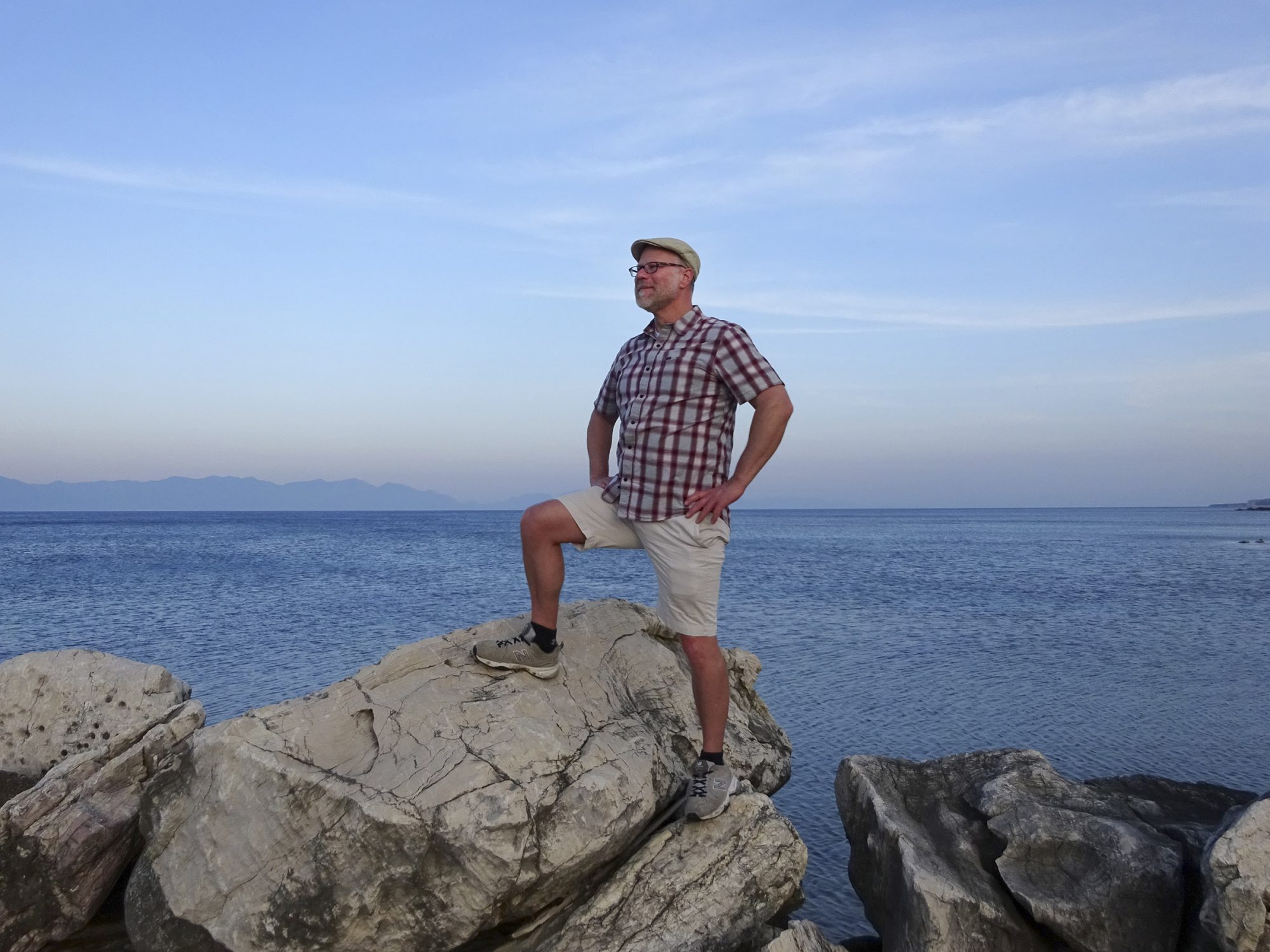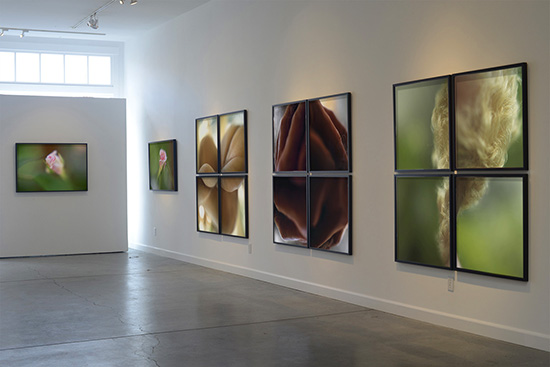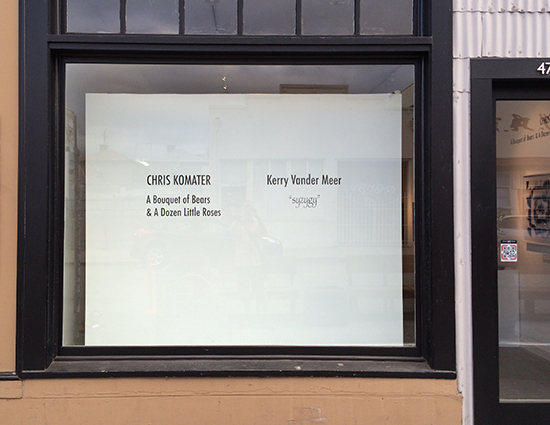Opening tomorrow, on view through Nov. 1
What I Did This Summer by SanFranChrisKo
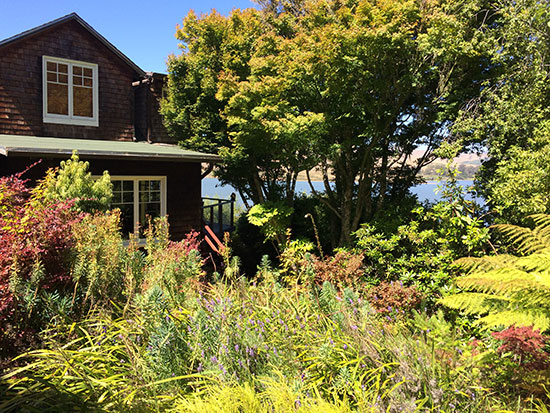
I’m up at my buddy David’s, enjoying a quiet weekend at his place in Point Reyes, overlooking the placid Tomales Bay, like sitting in a Monet painting, finally able to do some catching up.

For the past few months I’ve been preparing a show of my work, my first solo exhibition in 7 years. I’m showing now with an artists collective in Oakland, the Mercury Twenty Gallery. The thought of being with another commercial gallery—well, actually their collective sort of decision to not work with me, lol—pushed me into seeking an alternative venue to show my work in, one not constrained by profit or homogeneity, but defined by community and the support of ideas and creativity. The members of the collective are responsible for all aspects of running the gallery and presenting exhibitions. I have a backlog of projects, rejected over the past few years by the likes of Mark, Pat, Paule, Brian, and Bernie, that I’ll now have the opportunity of moving from my basement into the light of the white cube, that you all can finally see!, beginning with my recent projects Bouquet and A Dozen Little Roses that opens this Thursday.
So David. He and I dated briefly 20 or so years ago. He’s kind of exactly the guy that I should have settled down with, but I was distracted by the chubby men. Years go by without seeing each other, but whatever attracted us to each other in the first place keeps bringing us back together. He’s working on his memoirs in the garden, while I wait for the blur of my summer activities to coalesce into some internet appropriate narrative.
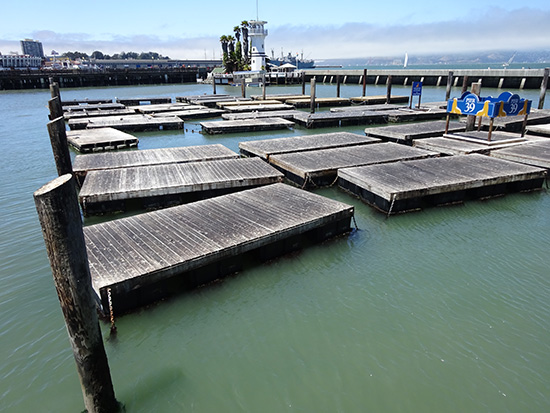
Big Chris’ big family visited. We took them to see the sea lions at Pier 39, via the touristy Hyde Street Pier and Pier 39, but they were all off mating somewhere. San Franciscans never visit this part of the city. And really, they shouldn’t. Seeing the remains of what was once a working port was sort of thrilling but also instilled a sad sense of loss in my otherwise chirpy proto-tourist demeanor. I love the crazy gospel people, though, the ones with the “He died for you” signs and portable amplification systems, next to the break dancers and old Chinese erhu players. Their sincerity and intensity and vaudevillian showmanship make for great family entertainment, like the 8-year old reverend Jimmy Joe Jeeter on Mary Hartman Mary Hartman. And I love hearing those Bible words, like “smite” and “asunder.”
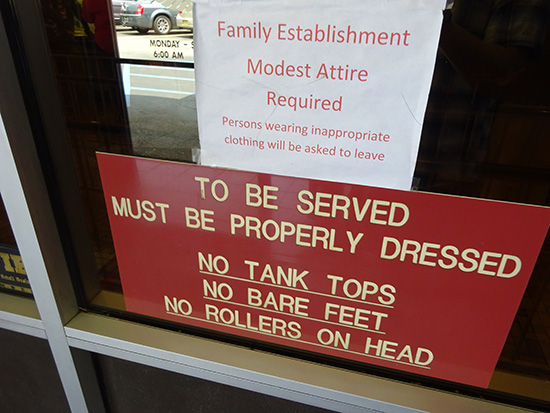
My mom flew to Chicago to spend some time with her sister, so I flew to Birmingham to dadsit. The downtown is really hopping, with a new arts district and lots of really great restaurants. Rather than replacing southern cuisine with healthy west coast or skimpy nouvelle stuff, they’re integrating other styles and flavors while emphasizing local ingredients and updating classic southern dishes. And you always get a square meal.

Same thing is happening in Sioux Falls, South Dakota. Chrissy and I flew out for Labor Day weekend to pick up d’Auggie’s little brother, Zoobie, the latest addition to our ever expanding alternative family. Zoobie is great, the brother of the Best Dog Ever, soon to be the Other Best Dog Ever. He’s soft and cuddly and does all the same bad things that his brother did when he was a small puppy, down to chewing on the same plant in my garden and peeing on the same spot in my kitchen. So Sioux Falls has this little foodie renaissance happening downtown. We ate at Parker’s Bistro. My favorite dish was a soup, a warm silky sweet potato soup with a puree of chilly avocado and cream swirled into it, stimulating the taste buds with contrasting flavor and temperature sensations. We had an amazing meal, at about 1/4 the price we would have paid in San Francisco. And a parking place right out in front! I’m thinking of becoming a part-time mid-westerner.
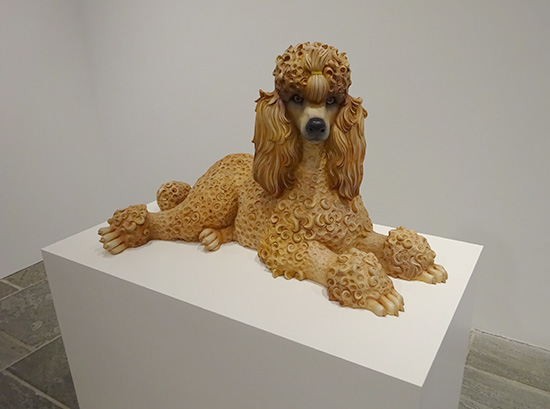
Chrissy and I flew to New York for a few days. Just to remind people: we are not boyfriends. Despite his looking like the kind of guy that I would marry, despite having dated him on and off for the past 15 years, and despite us doing everything together, we are not boyfriends. My boyfriend lives in Greece and is named Stavros and you can read about him in my past entries, and when he arrives next month for his periodic conjugal visit. So anyway, New York. The occasion of our visit was to see Cate Blanchett and Isabelle Huppert in Genet’s The Maids, two of our greatest actresses in a deliriously demented play. And Jeff Koons’ show was great! Shut up! People who don’t like his work probably don’t like puppies either.

What else did I do this summer? I sadly missed all chances to have anything other than my extremities exposed to the sun, and thus developed a pronounced farmer tan. High school buddies Jason and Weestro came to visit, and Archie and Vicki, and Lilly from New York. Lilly was being celebrated for her films at the Jewish something or other Center in Berkeley, and I went one night to see her amazing film about good-intentioned heroic Palestinian and Israeli women peacemakers who end up at each others’ throats by the end of the film. I introduced my buddy to her afterwards and he said something along the lines of “Well, I can’t imagine giving Manhattan back to the indians” which amazingly and almost surreally missed the entire point of not only Lilly’s film but the entire Palestinian peoples’ ongoing struggle to free their land from its occupiers. Lilly’s talk after the film was interesting more for the sparring that took place in the audience. This was a mostly over-70 crowd, mind you, and most seemed well acquainted with each other and with each other’s long developed and unchanging perspectives, and ready to pounce. When one calm and articulate rival of hers seemed to be getting too much positive attention, Lilly leaned into her mike and chastised her with “Hey, this evening is about ME, not about you.” I started a new photo project with spider webs, Bob’s and my book project got shelved by our publisher, Aimée made raspberry-topped chocolate cupcakes for Luna’s birthday that were the best treats of summer—actually the best sweet treats, the best savory were the forbidden victuals at Traif in Brooklyn. I saw hardly any art. I’m like a lapsed Catholic kind of artist. Well, actually, I should say that I saw hardly any art that I can remember. Except for Christopher Williams’ The Production Line of Happiness at MoMA, which so completely and with energetic theoretical rigor encompassed the entire art making visual technical consumerist experience. I saw a million movies, but really liked Blue Ruin, The Test, Pietà, Night Moves, Martin Gable’s only (directed) film The Lost Moment, Stranger by the Lake, 7 Boxes, Enemy, Romance and Cigarettes and Under the Skin.
Okay, back to the city…
An Afternoon on the River
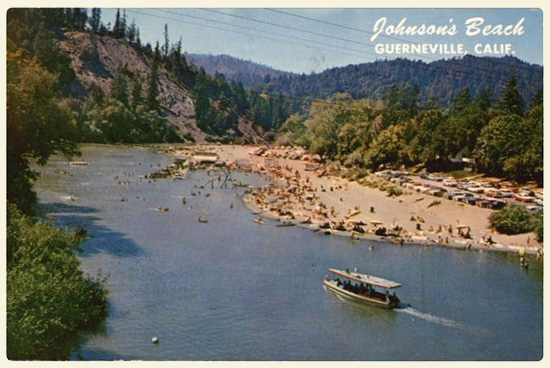
Friends of my niece Megan threw her a going away camping party in Guerneville a few weeks ago. Megan’s moving to Indonesia to marry her boyfriend of many years, Garna. My sister June and I drove up to spend the day with them at their campsite, envisioning toasted marshmallows and bonding around a campfire. When we got to the abandoned campsite, Megan sent me a text saying that they were at the beach in town and to join them there. I did bring sunscreen, but despite driving up to spend the day on the river, the image of that campfire bonding experience somehow didn’t include engaging with the river in any way, and I brought neither swim trunks, towel, hat, flip flops… nothing beachy. June neither. At the beach, Megan was alone, moodily contemplating her big move. Her friends had paddled upstream in their inflatable devices to do mushrooms. I felt so middle-aged, nervously envisioning what the psychedelic experience of drowning might be like, their smiling corpses soon floating back downstream to us.
My immediate concern was how to get comfortable on that hot rocky beach. Megan generously offered us a few inches of her towel to share, but I found a piece of plastic in my car that we used to separate our sweating bodies from the toasty beach, and my shoes and socks as pillows. Our conversation shifted between Megan’s plans, delivered from her comfy towel, Megan elegantly attired in her one-piece suit and wide-brimmed hat, and whether June and I should swim in our undies. Finally we just said we couldn’t take it anymore, sweatily kissed dear Megan goodbye, and headed to Safeway for electrolytes.
In the parking lot a nasty domestic encounter quickly escalated into a public spectacle. One stringy haired lady was duking it out nastily with another stringy-haired lady over some sad sack of a guy. Stringy hairs were pulled, halter tops ripped, sunglasses went flying, and at one point one of the stringy haired ladies–I surmised that she was the jilted lover–pointed at the poor sad sack’s package and screamed at the other stringy haired lady “That particular part of his anatomy is mine. Mine! Mine!!! You can’t have it, you multiple expletives deleted!” I really wanted to stay and see how this all resolved itself. I didn’t think that the injured former lover’s tactics seemed potentially very productive. Instead of bruised ribs and restraining orders, did she imagine some other possible outcome? “You know, my stringy haired darling, you’re right, this particular anatomical area is indeed yours—as is my heart. It not only brings a smile to my face to see you beating my lover and screaming at the top of your lungs in front of all these Safeway shoppers, it kind of turns me on… let’s go back to your place and make mad passionate love.”
Around that time, an article in the Chronicle appeared, detailing reasons to make Guerneville a vacation destination. Guerneville is indeed still kicking. And so are its ladies.
For Love and Glory
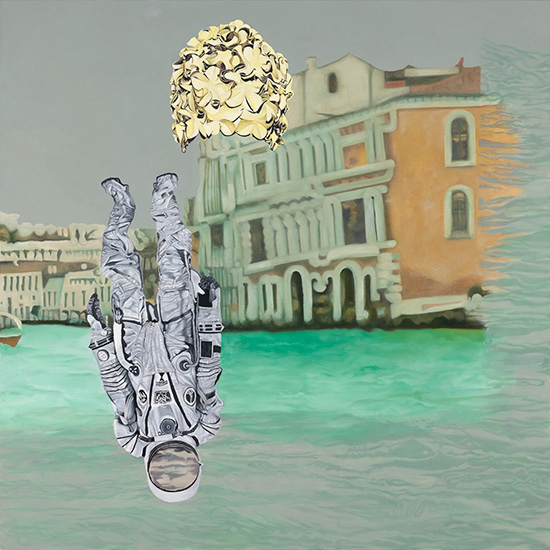
I stopped by Jack Fischer’s gallery in San Francisco last week, to see the work of my friend, Sarah Ratchye. Sarah led me and a delightful buddy of hers through the exhibition, For Love and Glory, which consists of graphite and silverpoint drawings, paintings, collages, and handmade wallpaper. There are images of lunar surfaces, octopus tentacles, ballet slippers, fabric, gems, floating astronauts, the Venetian lagoon, blood splattered space gloves… disparate images woven into a narrative that explores our interaction with the moon, both as graphic inspiration and potential living space. Well, and a lot more than that. Sarah explores the surface of the moon aesthetically and metaphorically, searching for meaning in our involvement and experience there.
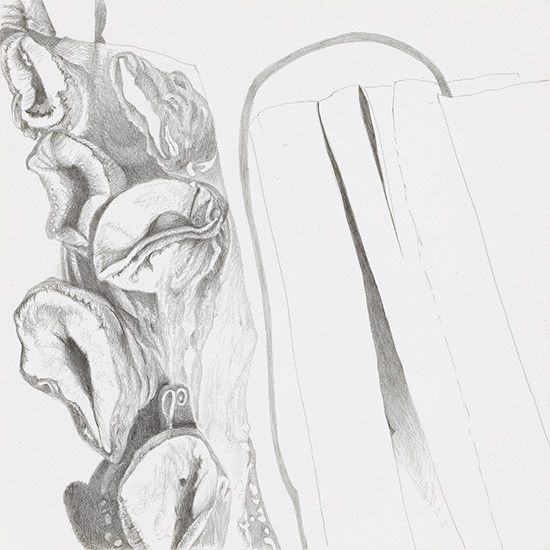
Her eyes light up when she talks about space junk, the “final frontier,” and bloody moon shoes. Yet like not wanting someone to spoil the end of the movie, I don’t want her to talk too much about this stuff and upset the experience of discovery. I could look at those silverpoints all day, lost in the folds of lunar landscapes, and suddenly there’s an arm, or those ballet slippers. There’s always deeper to dig, always some delightfully enigmatic image that frustrates an easy reading.
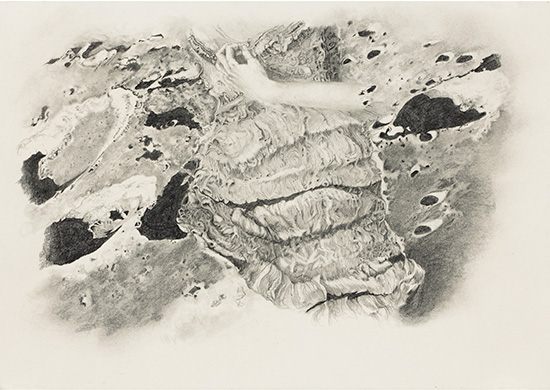
A particular favorite of mine, DIvr, has as a backdrop a blurry image of a few buildings on the Venetian lagoon. In the foreground, in sharp focus, are an upside down astronaut, the sea reflected in his silvery helmet, and above him a woman’s bathing cap, one of those fabulous mid-20th-century architectural rubber floral helmets that Esther Williams would have worn, removing it to reveal a perfectly coifed shimmery Technicolor ‘do. The background image dissolves on the right side of the canvas into a different plane of reflected lagoon water. The slight shifts in focus and perspective within the same canvas create a kind of soft Cubist space, but instead of letting us view an object from many perspectives within one picture plane, Sarah fills her painting surface with beautifully rendered psychologically rich images of different cultural and technological signifiers.
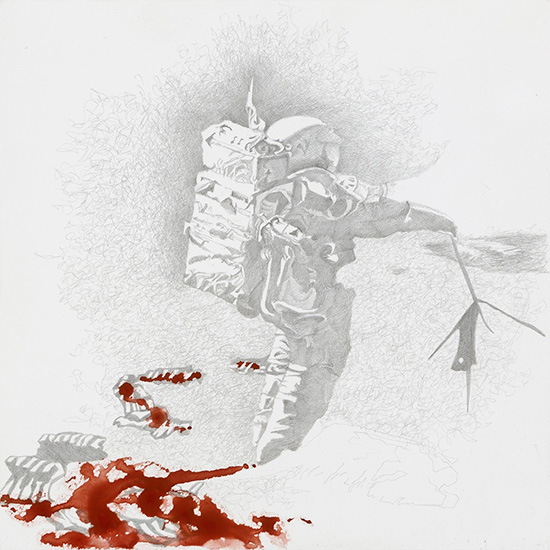
You could call her a lunatic, hahaha… One painting titled Menas, presents the moon as menace, seemingly entering the earth’s atmosphere–the sky is pink, the clouds black and brooding–yet the moon has these red blossoms around it, like a flower a kid would paint, and the surface of the moon so beautifully bright and crisply clear. If she can’t get to the moon just yet, the moon is finally coming to her, and in humanity’s end, she finds nothing but delight and wonder.
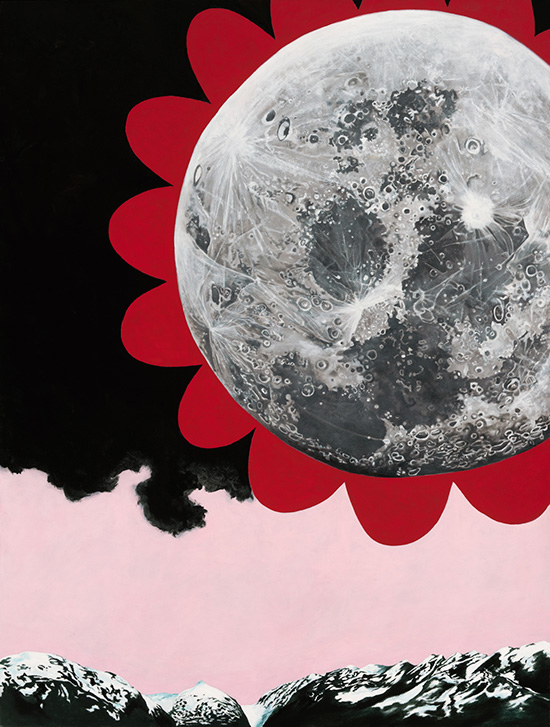
It’s not the same old story, Sarah’s tales of love and glory. On that you can rely.
On the Roads of Rhodes
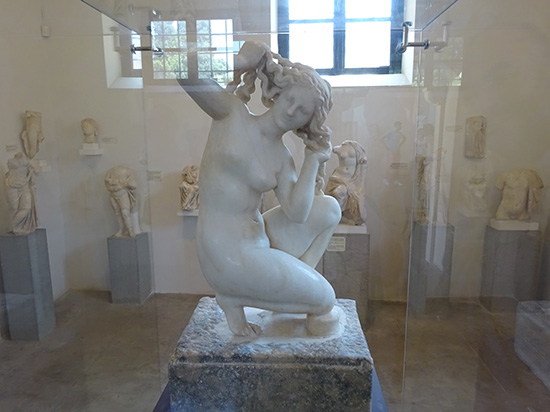
One of the first things I learned to say in my Greek lessons was Οι Éλληνες οδηγούν παρα πολύ γρήγορα–The Greeks drive too fast. I’d wondered why that would come before negotiating prices at the vegetable market, but now I know. Not only do they drive too fast, they come out of nowhere, driving twice as fast as you, and sniff your car butt until you get out of the way. Then they glare at you as they pass. I’m talking about guys, this is obviously a testosterone thing. And if they’re coming in the opposite direction, and want to pass cars on the opposite side of the road, you just have to figure out how the heck to get out of the way, because the possibility of a head-on catastrophe is made your responsibility, they seem oblivious to the notion. People of the United States, you have no idea what it’s like. Traffic signals are taken as suggestions. Stop signs and pedestrian boundaries and welfare are ignored. I remain a calm driver in spite of it all, humming Nancy Sinatra tunes as I’m passed and beeped at…
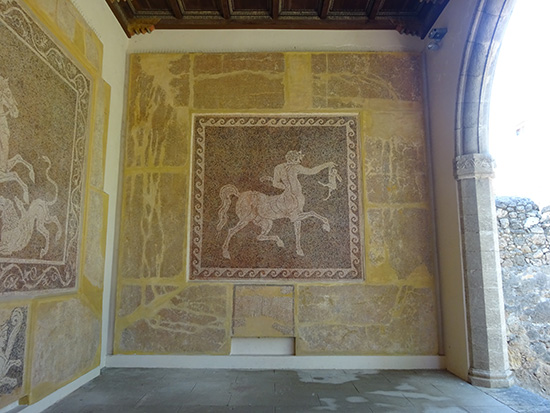
Rhodes was actually a pleasure to drive around in. There are so many tourists, all driving carefully along the steep cliffs and twisted medieval one lane roads, far outnumbering the road-ragey Greek guys.
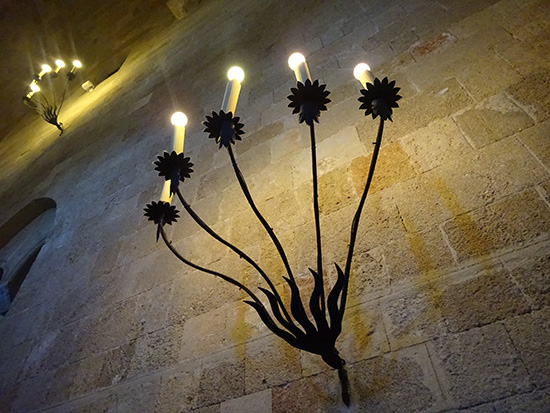
Rhodes old town is a beautifully preserved medieval city, with several grand museums. And you can see Turkey! Most of the architecture dates from the period of the Knights Hospitaller (14th to 16th century), who rebuilt much of the city on a grand scale before taking off for Malta.
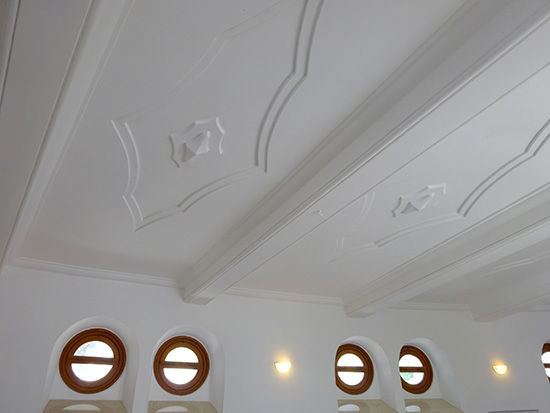
The italians controlled the island for only 30 years in the beginning of the 20th century, but restored everything, built a delightfully curvilinear seaside spa in Kalithea and deco buildings in Rhodes town, a beautiful fascist-y church to Saint Francis, a fake Alpine retreat, fountains everywhere… and then turned the keys over to Greece.
Inland, south of Rhodes town is Petaloudes, the Valley of the Butterflies. The oriental sweet gum trees attract a sub-species of the Jersey Tiger moth, which had not yet arrived in the great numbers that we thought were to be expected around this time of year. “June 20th,” the ticket seller told us, annoyed and with awesome specificity. The valley is beautiful though, lushly green and cool, and a hiking trail winds through it alongside a stream and up the hill to—I’m told, I didn’t quite make it—a monastery.
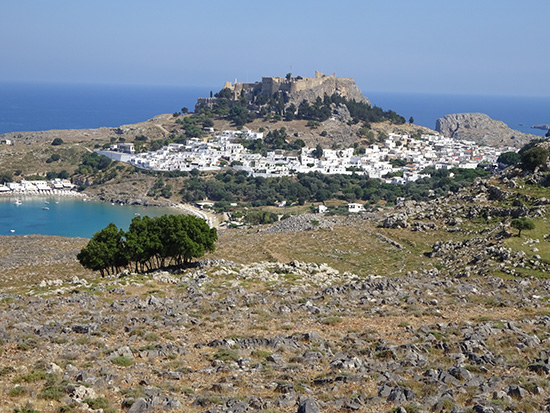
We spent several nights in Lindos, one of the most lovely towns in the Dodecanese, built under the shadow of a grand acropolis, on a tiny peninsula jutting out to the sea. Every restaurant has a rooftop terrace with stunning views of the sea and acropolis. And transportation through town on donkeys!
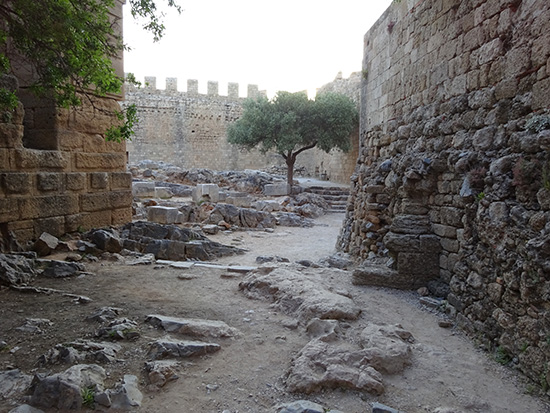
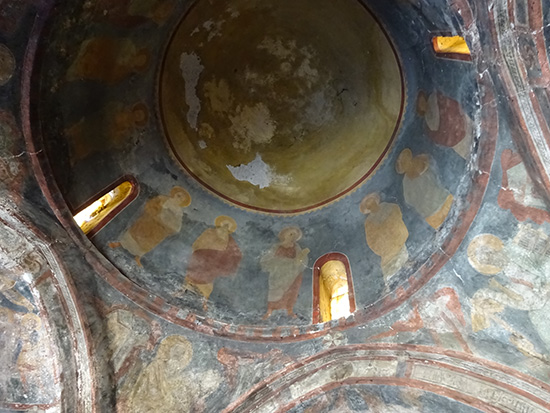
We met up with Stavros’ friend Markus, whom Stavros calls his son, because of his youth and clear need for a parental sort of guidance. Sitting on the open air terrace of a restaurant in Lindos, the acropolis and our burly furry-fingered bushy-eyebrowed waiter glowing and hovering warmly over us, I was again moved to tears as my dinner companions kind of ignored the fabulous atmosphere, unbelievably sexy staff, and wonderful food. “Meh, this view’s okay,” Stavros said as he looked into my teary eyes. “I hate lamb,” said Markus, as once again my eyes welled up as I took a bite of the delicious roasted lamb and chickpeas.
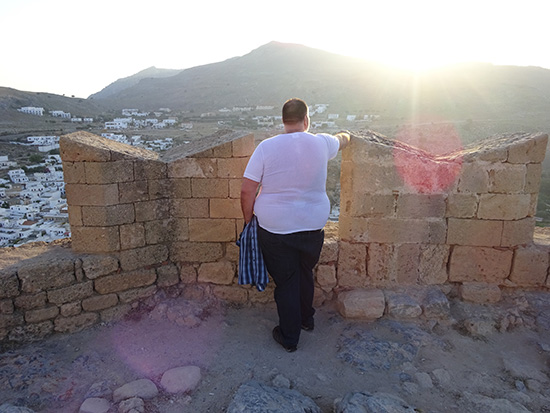
On the Watery Road to Santorini
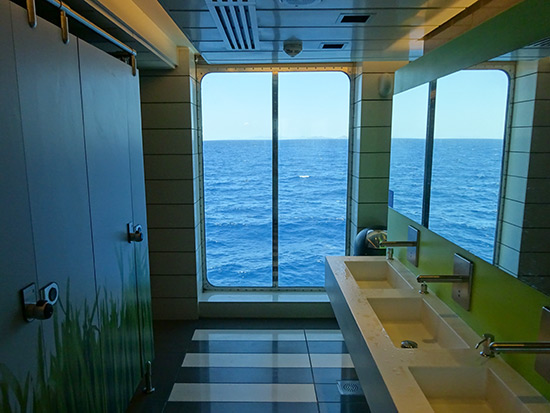
The Blue Star ferry to Paros has the most scenic mensroom anywhere–a floor to ceiling window framing nothing but sea and sky, undulating waves of blue zipping by to the sound of splishing, splashing and flushing. Stavros and I decided to spend the night in Paros, on our way to Santorini, to split up the 8-hour ferry ride. Paros is where Parian marble is from, where Praxiteles got his marbles.
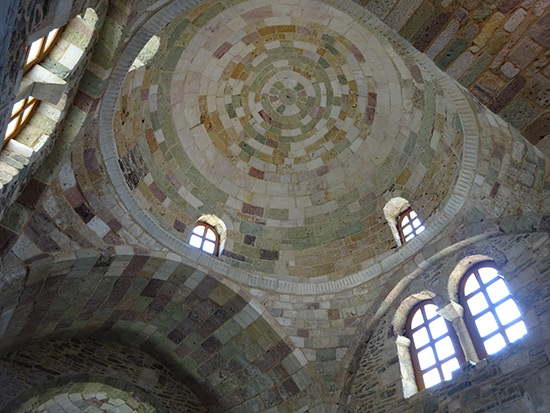
There’s a remarkable byzantine church there, founded by Constantine’s mom in the 4th century AD, Panagia Ekatontapyliani, which means “Church of 100 Doors.” I counted only a handful of doors, delighted by the conceptual conundrum of not only where these 100 supposed doors lead, but where they are in the first place.
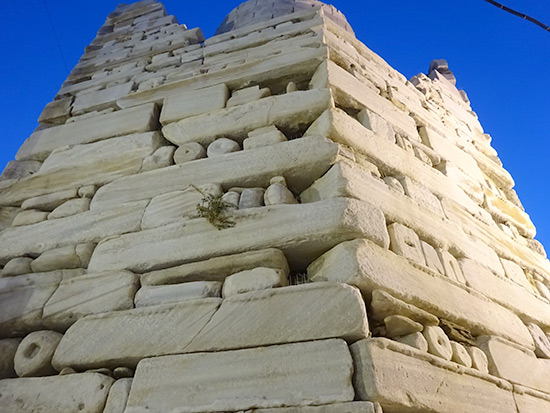
Up the hill from the church are the intriguing remains of a castle, built in 1260 by the Venetian Duke of Naxos. The castle was constructed using materials salvaged from the remains of nearby archaic and classical temples. The columns, stones and other architectural elements are stacked linearly, neatly, as if William Randolph Hearst were preparing to ship the temples back to the States for reassembly, a horrific and exhilarating assemblage of cultural and architectural obliteration.

Santorini is what remains after an enormous volcanic eruption about 3,600 years ago destroyed much of what was a single island, and created the current unbelievably scenic tourist destination: a central lagoon surrounded by 1,000 foot high cliffs on three sides. Entering the lagoon by ferry, you look up at these shimmery white towns perched on the top of the gray cliffs, spilling down like vanilla icing on a giant partially eaten bundt cake.
On the bus from the ferry landing to Thira, the main town, looking out the window you see what appear to be many low-growing shrubs, which are actually grape vines. The grape growers weave the vines into circular sort of baskets, very low to the ground, so that the grapes grow on the insides of the baskets, protecting them from the harsh wind and heat. After about 75 years, the vines are cut to the roots, and new vines grafted on. Some of the roots are centuries old, very helpful in an environment that offers little moisture retention.

We explored Akrotiri, a Minoan Bronze Age settlement that was buried under the volcanic ash of the big eruption that I mentioned. Only 10% of the site has been excavated and archaeologists have already uncovered remains of multi-story buildings and frescoes, incredibly preserved. You can see some pottery at the site, but the major finds are nearby in the Museum of Prehistoric Thira, including the delightful Blue Monkeys fresco.
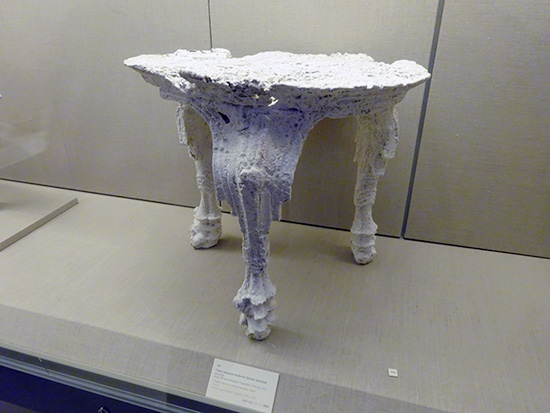
As at Pompeii, plaster has been poured into empty spaces in the ash, revealing the forms of buried objects that deteriorated and disappeared centuries ago. One cabriole-legged table, in particular, anticipated the Queen Anne leg by some 33 centuries.
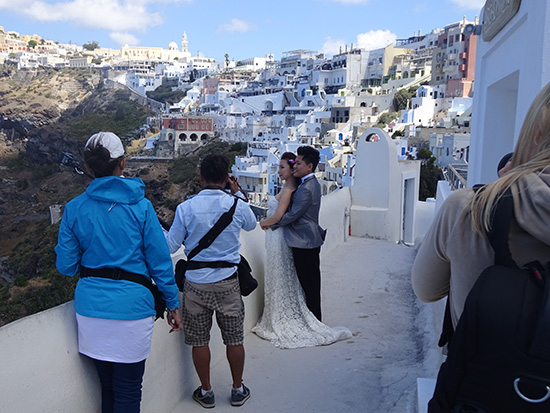
Everywhere on the island are Asian brides and their photographic entourages, zipping gleefully from one photogenic spot to the next with their white gowns and grooms. At night music pulsed, drunk guys peed in dark corners, aggressive touts beckoned us into their restaurants, stray cats screeched… but as we spilled down the hill, one block towards the caldera, all was silent, no one in sight, just moonlight illuminating the simple curves and angles of Cycladic buildings, churches, and terraces.
We took the express catamaran ferry back to Piraeus. It was supposed to have cut three hours off the trip, but our departure was delayed by two hours and the trip took an hour longer than scheduled. The ferry is about 1/8 the size of the majestic Blue Star ferry that brought us to Santorini, everyone crammed into airplane-like sardine can seating. It was a crazy bumpy ride, like being in the space shuttle. I got up to pee and was tossed back and forth in the aisles, and, imagining the scene I’d confront in the bathroom, bounced back into my seat. When we arrived in Piraeus, there was the Blue Star Ferry from Santorini, everyone disembarked hours before. I looked up at the window into that beautiful mensroom and made a beeline for the nearest dark corner.
Next stop, Rhodes… Stay tuned!
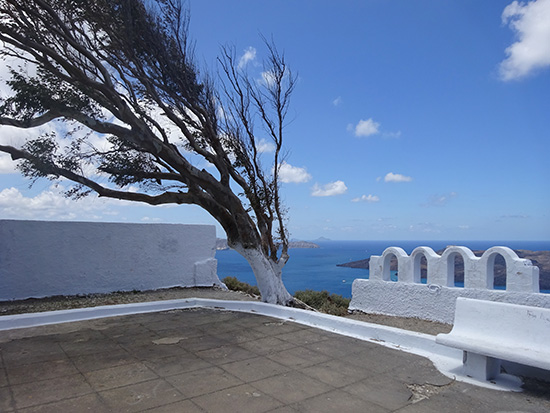
French Kissing in the Peloponnese
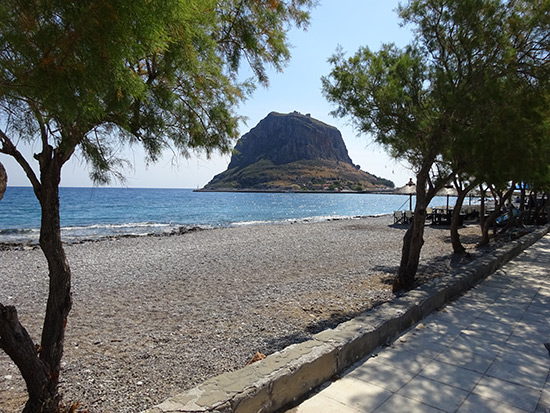
Here I am, back in Greece, back in Plateia Amerikis, the plaza of my people. I’ve been traveling around the country with Stavropoochie for the past month, now in Athens for a breather and a blog update before heading back to San Francisco next week.
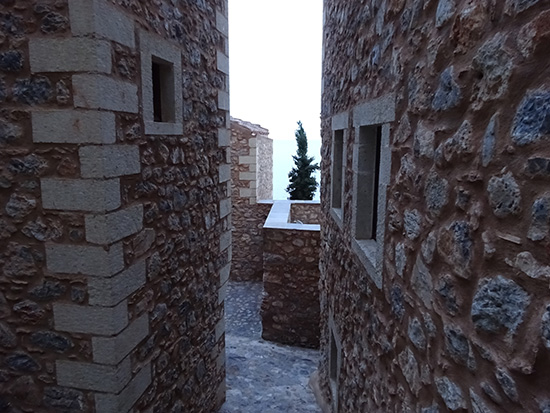
We started our adventure in Monemvasia, a walled medieval city on a big rock of an island just off the coast of the southeastern Peloponnese. It’s so romantic there, like unbelievably romantic, medieval towers, surrounded by the sea below and ruins of the older town above… Lyrical, pastoral, melancholic… We ate in a restaurant in a 16th century building with stunningly beautiful views of the sea. I was almost moved to compose an Ode on my spinach pie. The French couple sitting next to us, after their second bottle of wine, couldn’t control their Frenchiness and abruptly grabbed each other across the table and started French kissing, right over their salata horiatiki, cigarettes dangling from their roving hands and enveloping the rest of us in a smoky haze as they licked each other’s faces, audibly, a symphony of cats joining in with their own hungry meows.
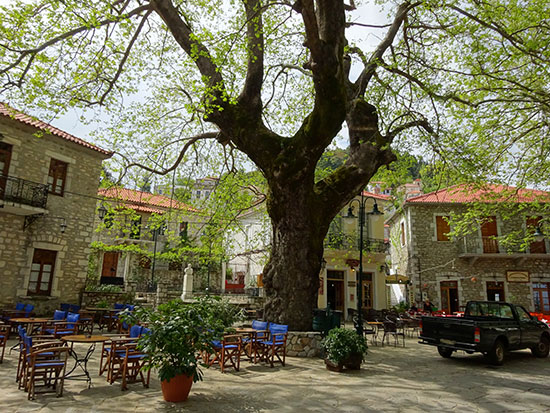
Our next stop was for galaktoboureko in Kosmas, a sweet little confection in a sweet little hilltop town shaded by beautiful old plane trees. Galaktoboureko is an intense experience of sugar conveyed through the mediums of custard and filo, the whole thing actually submerged in drippy sugar syrup. It’s like drugs. I sat in the empty square with Stavros, under the plane trees, silently composing “Ode on a Slice of Galaktoboureko” in my hyperglycemic stupor. The town was destroyed in WWII but rebuilt exactly as it was before, and hopefully as it will stay forever. We visited Leonidio, a town surrounded by dramatic red cliffs. The older inhabitants there speak a language called Tsakonian, sort of like garbled Greek.
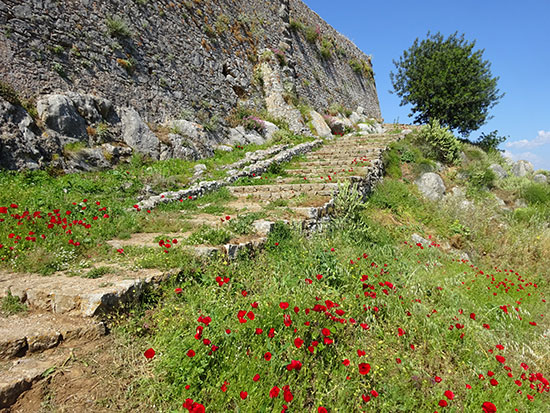
We based our exploration of Laconia, Aracadia and Argolis in Nafplio, a lovely port city with many neoclassical buildings and the nicest sidewalks in Greece. You can actually walk on them. Sidewalks in Greece are generally not very safe, aesthetically pleasing, coherent, or even seemingly designed to walk on. They have these ridged yellow tiles that are supposed to help the blind, but they lead to nowhere, they’re often covered by cafe seats or other obstacles, and trees are planted right in the middle of their path. I’ve never seen a blind person attempt to navigate the sidewalks. Everybody walks in the streets instead. In these narrow streets filled with insane Greek drivers and even crazier velo-terrorists who see their bikes as an extension of their pedestrianism. Anyway, Nafplio, it was named the first capital in 1829 by the first head of the newly liberated Greek state. It was also where he was assassinated two years later. Walking around the streets we watched the final moments of the Eurovision song contest, projected on a big screen, and savored the victory of Conchita Wurst, the bearded queen of Austria. There wasn’t a controversy in Greece over her outfit, as the guys here have been wearing dresses for quite some time.
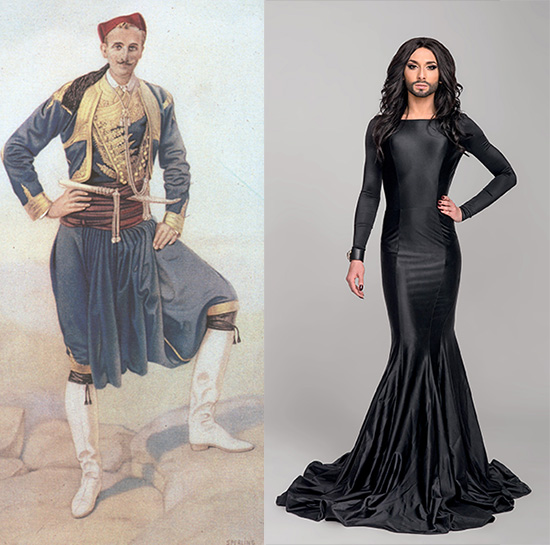
After visiting the theater at Argos we visited the temple and stadium at Ancient Nemea. The site has been funded, excavated and restored by a team from the University of California at Berkeley. It’s the only archaeological site I’ve been to that has a rose-lined path, grass, a ha-ha, actual “Watch your step!” signs, and plaques everywhere with the names of Greek-American project sponsors. Even the marble picnic table had a sponsor’s name carved into it!
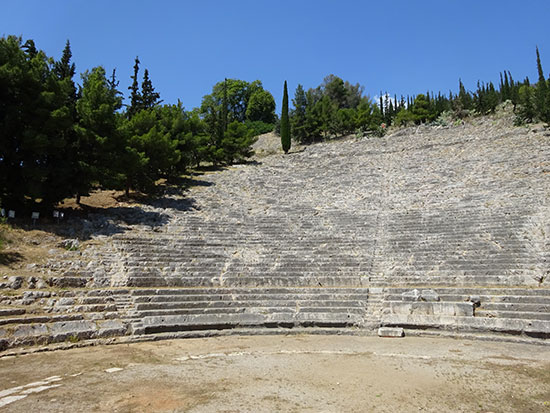
One souvlaki pita each at Pita Pan, and we headed back to Athens… Next up: Paros and Santorini. Stay tuned!
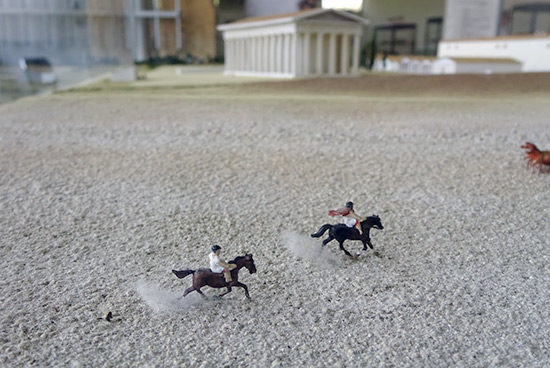
Louie and Hans and Vicki and Me
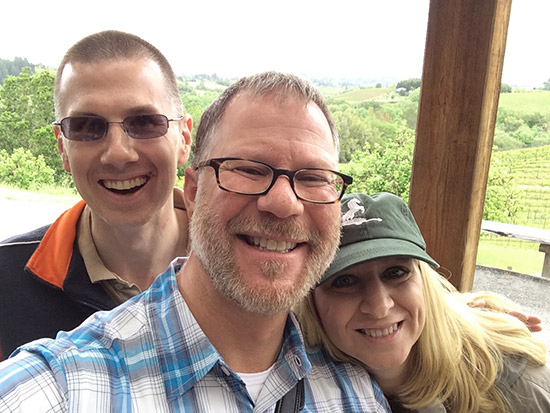
I watched an episode of Louie that I downloaded the other day here in Athens. At one point Louie mentions never having experienced the death of a loved one. Louie is a few years younger than I, and I immediately envied that cluelessly blissful loss-less state. My lover died when I was 28, then my best friends, countless other friends and compadres, ex-lovers, beloved neighbors, then my sister…. How did he, or his character, avoid the death of a loved one?
My super-nicest-guy-in-the-world cousin Hans was killed last week, hit by a car while riding his bike. We had been wine tasting a few weeks before in the Russian River, just a few days before I left for Greece. At a dinner at a winery after our day of tasting, he lapsed into his usual I-love-you-man brosexual tipsiness. His wife, my cousin Vicki, was obviously annoyed, eying him across the table with a glare that betrayed a familiar annoyance, a scene perhaps repeated, but which she lovingly tolerated, like the rest of us. His nature was so easy-going, so open and friendly and loving… those qualities became amplified by the fantastic wines they introduced me to that day. If in semi-consciousness we reveal more of ourselves, Hans confirmed what we already knew. Everyone understood this about him as soon as they met him, that he was a good person, and that he loved being alive.
The guy who ran him over left the scene, turning himself in a few days later saying it was a horrible accident, that he thought he had hit a deer. I’ve been fortunate in being able to say goodbye to most of my loved ones, frequently sharing their last breaths… but Hans was just forgotten on the side of the road. There’s no real sense of closure, no sense of a life that was ready to end, just a tragedy and a profound absence that we have to puzzle and grieve through. Vicki had found her ideal mate, the balance in their relationship pitched to delightful perfection. Because someone else was momentarily distracted, her life is forever changed.
When someone dies, people apologize, they offer condolences, they ask if there’s anything they can do… These kinds of statements mean so little to me, revealing a detachment from the anger, grief, frustration and helplessness that we’re feeling. I can only say that I’m sad, so very sad. Death is a part of life, and we learn to live with it. But not Louie, not yet anyway, and I hope his character always remains in that state.
Dinner and a Movie. And a Show.
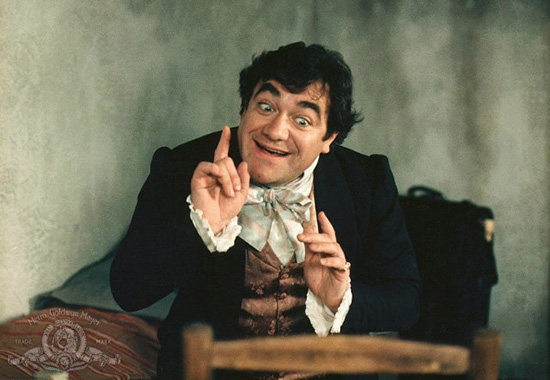
Bob had me over to watch Babette’s Feast. He made beer bread soup, taking inspiration from a culinary corner of the film that isn’t the one that usually inspires such activity. He took some liberties with the recipe in the film (beer, water and bread), including the addition of pureed fresh peas, which provided some much needed vegetable matter as well as a not entirely pleasant green tint that brought to mind scenes from The Exorcist more so than Babette’s Feast. I brought over some plundered Pliny the Elder beer from a visit last week to the Russian River Brewing Company in Santa Rosa. The beers there are lip-smackingly delicious, covering the entire breadth of tastebud sensation, from sweet caramel to sour cherry. After dinner and the movie, we went to Oddball Cinema on Capp to check out the evening’s show of vintage erotic films. One film from 1970 was a filmic equivalent of the sexual experience—lots of blurry red body parts, hair, and panting—and came the closest to creating a sensual and erotic atmosphere. But generally, the films were the stuff of stag parties in the 1950s and 60s, mostly titillation, except for a disturbing screwball comedy porn flick from the silent era starring a trio of scantily clad beach beauties, a horny little dude, and a goat. Another prescient silent film depicted the developing medium of television as a potential means of bringing topless women into the homes of frustrated adolescents.
David and I went to see Morgan James at the Venetian Room. She’s a young singer with a powerful voice who idolizes Nina Simone, one of the great song-stylists of the 20th Century, and while singing her tunes, channels instead that high-pitched Broadway belting style that is about as far as one can get from Nina Simone. She did deliver a few amazingly forceful interpretations of jazz standards that went slightly beyond her Jazzy Little Mermaid voice into the realm of soulful interpretation. I really should have taken notes, because I can’t for the life of me recall the particular songs, but if you like that kind of powerful high decibel singing free of burdensome emotional content, she’s the singer for you!
